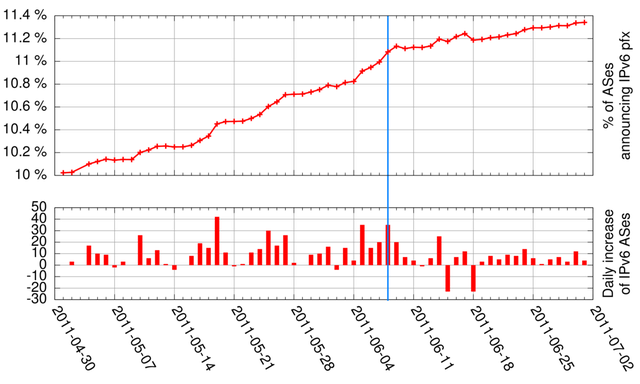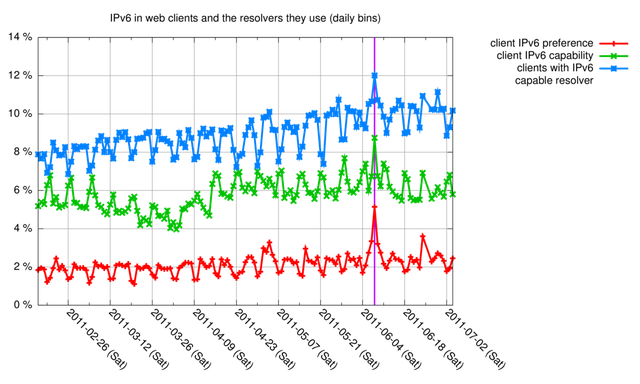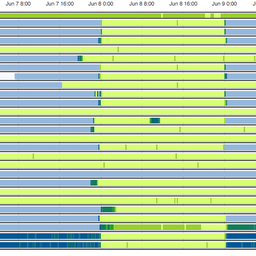In this article we'll look at some of the more long-term effects of World IPv6 Day, as seen in our measurements a number of weeks after the event itself.
World IPv6 Day was a test flight of dual-stacking content. And while it was successful in accomplishing that goal, it also served as a flag date for people to deploy IPv6 in their networks and keep it running after the day. Now, a few weeks after World IPv6 Day, it's interesting to see what its longer term effects are.
Content reachable over IPv6
One way of looking at IPv6 deployment is to examine content available over IPv6. A number of parties are tracking this for the worlds most visited websites (as determined by Alexa ), most notably Dan Wing , Eric Vyncke and the MNlab at the University of Pennsylvania. In Figure 1, you can see the percentage of websites that is reachable over IPv6, based on daily measurements by Dan Wing from a host that is not on Google's IPv6 whitelist . On World IPv6 Day, close to 4% of the Alexa 1M sites was accessible over IPv6. Perhaps more interesting is that World IPv6 Day also seems to have caused a jump from 0.4% to 0.7%. This difference between pre- and post-World IPv6 Day is even more pronounced for the top 25,000 sites in the Alexa list, of which over 1.1% are accessible over IPv6 as of the last measurement in this graph.

IPv6 enabled networks (ASes)
It was specifically not a goal of World IPv6 Day to enable IPv6 on access networks for the day itself and then turn it off again. As can be seen from Figure 2 this didn't happen. This figure shows the same data as http://v6asns.ripe.net/ but on a per day level of detail.

This graph shows that in the weeks before World IPv6 Day the daily increase of networks that announce one or more IPv6 prefixes was larger then after World IPv6 Day. This could be due to operators using World IPv6 Day as a flag date by when they wanted their deployments in production. This pushed deployment dates to the period just before World IPv6 Day, which in turn slowed down the growth the period just after. Also interesting to note is that on World IPv6 Day 40 more networks announced one or more IPv6 prefixes then the day before, out of a total of 38,349 ASes in the global table. This is higher then usual, but the weeks before show a couple of days that had similar peaks. Finally note that the dates written out on the time axis are all Saturdays, so it's easy to see that, understandably, operators don't deploy IPv6 in weekends. The big exception on this is the Sunday before World IPv6 Day, where 35 more networks where seen announcing an IPv6 prefix then the day before.
Effects on IPv6 capability/preference on end user systems
The clients visiting www.ripe.net definitely were different on World IPv6 Day, we saw quite a spike in IPv6 preference on clients as can be seen in Figure 3, where the purple vertical line indicates World IPv6 Day. This is likely in large part due to people visiting our website to test their IPv6 connectivity, by using the IPv4/IPv6 indicator on our front page. Figure 3 shows an excerpt from a longer running measurement on the IPv6 preference and capability of web clients visiting www.ripe.net and the resolvers they use. As www.ripe.net is typically visited by network operators and other people with a strong bias for networking, it is not surprising that the client IPv6 preference of a little over 2% we see (red line) is about 6x higher then the numbers reported by Google .

For this client population there is only slight growth in IPv6 preference. Between February and June the resolvers that the clients are using become more IPv6 capable (blue line), going from 8% to 10%. This correlates with the growth in ASes that announce an IPv6 prefix, and shows operators deploying IPv6 on infrastructure.
The difference between client IPv6 preference (red line) and IPv6 capability (green line) is caused mainly by transition technologies like 6to4 and Teredo. The IPv6 capability is dropping in March 2011, which was also a period where we didn't use a local 6to4 relay, but started depending on an external one. We switched again in April to a much stabler external 6to4 relay, which shows what an effect 6to4 relays external to your network can have, if you don't provide this by yourself.
There are more and more voices to get rid of some transition technologies, as they are the main course of broken dual-stack situations, but we don't see that reflected in our statistics yet as the difference between the IPv6 preference and capability of clients doesn't decrease. Probably because this would be something done by OS vendors and CPE manufacturers, and would take significant lead time.
Conclusion
World IPv6 Day had a lasting effect, which is clearly visible when looking at increase in content that is available over IPv6 now. Still, 0.7% is not exactly an abundance, so it would be good if some of the larger content providers would deploy dual-stack permanently.
The effect on ASes was less clear, but it looks like people used World IPv6 Day as a flag day to have their IPv6 deployments finished. In that sense, having more World IPv6 Days (or Weeks, Months), would be very welcome.
If people have other indicators of global IPv6 deployment acceleration due to World IPv6 Day, please comment below.








Comments 0
The comments section is closed for articles published more than a year ago. If you'd like to inform us of any issues, please contact us.